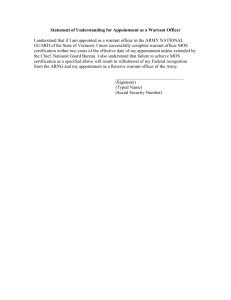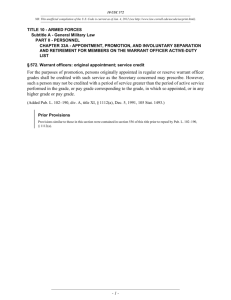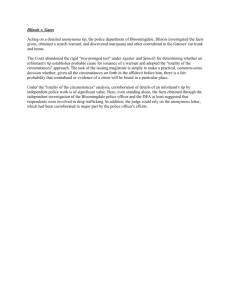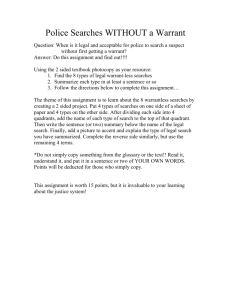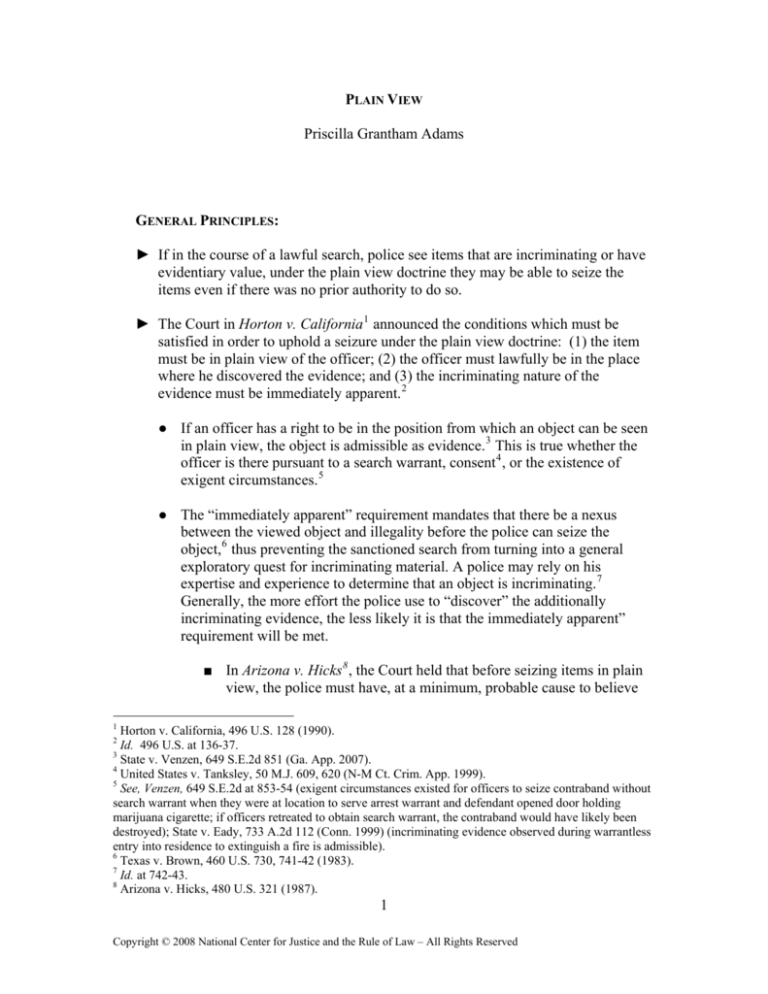
PLAIN VIEW
Priscilla Grantham Adams
GENERAL PRINCIPLES:
► If in the course of a lawful search, police see items that are incriminating or have
evidentiary value, under the plain view doctrine they may be able to seize the
items even if there was no prior authority to do so.
► The Court in Horton v. California 1 announced the conditions which must be
satisfied in order to uphold a seizure under the plain view doctrine: (1) the item
must be in plain view of the officer; (2) the officer must lawfully be in the place
where he discovered the evidence; and (3) the incriminating nature of the
evidence must be immediately apparent. 2
● If an officer has a right to be in the position from which an object can be seen
in plain view, the object is admissible as evidence. 3 This is true whether the
officer is there pursuant to a search warrant, consent 4 , or the existence of
exigent circumstances. 5
● The “immediately apparent” requirement mandates that there be a nexus
between the viewed object and illegality before the police can seize the
object, 6 thus preventing the sanctioned search from turning into a general
exploratory quest for incriminating material. A police may rely on his
expertise and experience to determine that an object is incriminating. 7
Generally, the more effort the police use to “discover” the additionally
incriminating evidence, the less likely it is that the immediately apparent”
requirement will be met.
■ In Arizona v. Hicks 8 , the Court held that before seizing items in plain
view, the police must have, at a minimum, probable cause to believe
1
Horton v. California, 496 U.S. 128 (1990).
Id. 496 U.S. at 136-37.
3
State v. Venzen, 649 S.E.2d 851 (Ga. App. 2007).
4
United States v. Tanksley, 50 M.J. 609, 620 (N-M Ct. Crim. App. 1999).
5
See, Venzen, 649 S.E.2d at 853-54 (exigent circumstances existed for officers to seize contraband without
search warrant when they were at location to serve arrest warrant and defendant opened door holding
marijuana cigarette; if officers retreated to obtain search warrant, the contraband would have likely been
destroyed); State v. Eady, 733 A.2d 112 (Conn. 1999) (incriminating evidence observed during warrantless
entry into residence to extinguish a fire is admissible).
6
Texas v. Brown, 460 U.S. 730, 741-42 (1983).
7
Id. at 742-43.
8
Arizona v. Hicks, 480 U.S. 321 (1987).
2
1
Copyright © 2008 National Center for Justice and the Rule of Law – All Rights Reserved
the item is contraband or evidence of criminality. 9 In Hicks, the police
entered an apartment after a shot was fired from within. While in the
apartment, the police saw stereo equipment they suspected was stolen
and therefore moved the components in order to find and record the
serial numbers. 10 The Court found that moving the equipment
constituted a search, separate from the search for the shooter, victims
and weapons that predicated the officer’s entry into the apartment. 11 A
mere inspection of the equipment would not have constituted a search
in that it would not have been an additional invasion of the
respondent’s privacy interest. 12 Turning to the question as to whether
the search was reasonable, the Court began with the finding that the
plain view doctrine which allows, under certain circumstances, police
to seize evidence in plain view without a warrant, can apply to a search
as well. 13 Therefore, the separate search would be valid as long as the
plain view doctrine would have sustained a seizure of the stereo
equipment. 14 The Court held that since the officer did not have
probable cause to believe the stereo equipment was stolen, the plain
view doctrine was not applicable. 15
■ Likewise, in People v. Blair, 16 the court held that the seizure of
defendant’s computer was not justified under the plain view doctrine;
discovery by police of bookmarks with references to teenagers might
constitute reasonable suspicion that the computer contained child
pornography, 17 but did not rise to the requisite level of probable
cause. 18
► Must discovery be “inadvertent?”
While noting that inadvertence was a characteristic of most legitimate plain view
seizures, the Court in Horton v. California 19 stated it was not a necessary
requirement, 20 reasoning that an inquiry as to whether a discovery is inadvertent
focuses on the subjective state of mind rather than the objective standard under
the totality of circumstances analysis. 21 Nevertheless, some courts still address the
9
Id. at 326.
Arizona v. Hicks, 480 U.S. at 323.
11
Id.at 324-25.
12
Id.at 325.
13
Id. at 326.
14
Id.
15
Id.
16
People v. Blair, 748 N.E.2d 318 (Ill. App. 2001).
17
Id. at 323.
18
Id.
19
Horton v. California, 496 U.S. 128.
20
Horton, 496 U.S at 130.
21
Id. at 138.
10
2
Copyright © 2008 National Center for Justice and the Rule of Law – All Rights Reserved
issue of inadvertence in determining the propriety of seizures under the plain view
doctrine. 22
● In United States v. Carey, 23 the Tenth Circuit seemed to read a requirement of
inadvertence into the plain view doctrine. 24 In Cary, the police was searching
defendant’s computer for evidence of drug trafficking and noticed several JPG
files with sexually explicit file names. 25 He opened one of the JPG files and
upon discovering child pornography, downloaded approximately 244
additional JPG files, transferred the files to disks and proceeded to view the
contents of 95 to 133 files. 26 After doing so, the police resumed his search for
evidence of drug trafficking. 27 Relying on the officer’s testimony that each
time he opened an additional JPG file he expected to find child pornography,
the court reasoned that the contents of these files were not inadvertently
discovered, and therefore not admissible under the plain view doctrine. 28 By
opening the additional JPG files that he believed would contain child
pornography, the court stated that the detective had in effect abandoned his
search for drug-related documents. 29
PLAIN VIEW AND COMPUTERS
A. Images or Information on the Computer Screen
If police are lawfully in a place and see an image or document on a computer
screen and its incriminating nature is immediately apparent, their observations
will be considered in plain view and the evidence may be seized under the plain
view doctrine. 30 If, for example, police are conducting a lawful search under a
warrant for evidence of a crime and see an image of child pornography on the
computer screen, the image will be admissible under the plain view doctrine. In
State v. Mays 31 police were lawfully in defendant’s home to investigate the claim
made by the victim that defendant had beaten him. 32 The defendant invited the
officers in, and in the course of looking for signs of a struggle, police saw the
message “[H]e will die today” on the computer screen. 33 The court held that the
22
United States v. Carey, 172 F.3d 1268, 1273, n.4 (10th Cir. 1999); United States v. Gray, 78 F. Supp. 2d
524, 529 (E.D. Va. 1999).
23
Carey, 172 F.3d 1268.
24
Id. at 1273.
25
Id. at 1270.
26
Carey, 172 F.3d 1271.
27
Id.
28
Id. at 1273.
29
Id.
30
Tanksley, 50 M.J. at 620 (observation of information on computer screen in plain view thus justifying
seizure of diskette containing it from the computer).
31
State v. Mays, 829 N.E.2d 773 (Ohio Ct. App. 2005).
32
Id. at 777.
33
Id. at 779.
3
Copyright © 2008 National Center for Justice and the Rule of Law – All Rights Reserved
warrantless seizure of the computer was justified under the plain view doctrine, as
the message was clearly indicative of criminal activity. 34
B. Images or Information in Computer Files
The question as to what constitutes plain view in the context of computer files is
an issue that has not been resolved by the courts. The determination rests largely
on how the court views computers and searches of computers. Many courts view
computers as containers capable of storing information (albeit in digital form) just
as a filing cabinet stores paper records and documents. 35 Courts adopting the
“computer as container” approach view data in a computer as simply another form
of document; therefore, a search warrant for writings or records encompasses a
search of computer files. 36 If a search for computer data is merely a document
search, police are bound by the same rules whether the information is in a
computer, a desk, or a filing cabinet.
Other courts reject the filing cabinet analogy, finding that it is too simplistic in
light of the variety and vast quantity of information that is stored in computers; 37
therefore law enforcement must take a “special approach” when searching for
data on a computer. 38
That is, while police might have some degree of suspicion that something
they see in the course of a lawful search is contraband or evidence of
criminality, they may not do anything that constitutes a new search to gain
the requisite probable cause. 39
1. Special Approach:
● United States v. Carey, 172 F.3d 1268 (10th Cir. 1999).
The Tenth Circuit in United States v. Carey, 40 asserted that “the file
cabinet analogy may be inadequate” due to the massive quantity and
variety of information that can be stored in computers. 41 The Carey
court said that when searching computers officers should employ
special methods, such as searching according to the file types or titles
34
Id.
United States v. Al-Marri, 230 F. Supp. 2d 535, 541 (S.D.N.Y. 2002).
36
See, United States v. Hunter, 13 F. Supp. 2d 574, 581 (D. Vt. 1998); United States v. Musson, 650 F.
Supp. 525, 531 (D. Colo. 1986); Frasier v. State, 794 N.E.2d 449, 454, 460 (Ind. Ct. App. 2003).
37
Carey, 172 F.3d at 1275.
38
Id. at 1275 n.7.
39
See, e.g., Arizona v. Hicks, 321 U.S. at 325; United States v. Osorio, 66 M.J. 632 (A.F. Ct. Crim. App.
2008); People v. Blair, 748 N.E.2d 318 (Ill. App. 2001).
40
Carey, 172 F.3d 1268 (10th Cir. 1999).
41
Id. at 1275.
35
4
Copyright © 2008 National Center for Justice and the Rule of Law – All Rights Reserved
listed in the directory, to avoid searching files not of the type specified
in the warrant. 42 Furthermore, when police come across intermingled
documents, they must engage in the intermediate step of sorting the
documents and searching only those specified in the warrant. 43
In Carey, an investigator was searching a computer pursuant to a
warrant to search for records of drug distribution when he came across
an image that appeared to be child pornography. The detective
continued to open additional JPG files in order to confirm that they
contained child pornography.
The court found that the first image of child pornography was
admissible under the plain view doctrine 44 because the investigator
had to open the file and examine the contents to determine what the
file contained. 45 By opening the additional JPG files in which he
expected to find child pornography, the detective abandoned his
original authorized search for evidence of drug trafficking and began
a new search for evidence of child pornography. The court held that
the additional images of child pornography were inadmissible since
they were not authorized by the warrant. 46 Although declining to rule
on the issue of what constitutes plain view in the context of computer
files, the Tenth Circuit said that the images of child pornography were
not in plain view because they were located in closed files. 47
●
United States v. Osorio, 66 M.J. 632 (A.F. Ct. Crim. App. 2008).
Relying on the Tenth Circuit’s rationale in Carey, the court in United
States v. Osorio 48 found that search warrants for computers must
contain specificity not only as to the scope of the warrant, but also as
to the process which will be used to conduct the search. 49
Plain view cases are best analyzed on a fact-specific, case by case
manner. Osorio clearly illustrates this point: based on the facts of the
case, the Air Force Court of Criminal Appeals found that an agent
went outside of the scope of the search warrant and therefore the
images she viewed were not admissible under the plain view doctrine.
In Osorio, agents had a search warrant to search appellant’s laptop
computer for photos relating to an alleged sexual assault that occurred
42
Id. at 1276.
Id. at 1275.
44
Carey, 172 F.3d at 1273 n.4.
45
Id. at 1273.
46
Id.
47
Id.
48
Osorio, 66 M.J. 632 (A.F. Ct. Crim. App. 2008).
49
Id. at 637.
43
5
Copyright © 2008 National Center for Justice and the Rule of Law – All Rights Reserved
at a party. The appellant was not under any suspicion of wrong doing.
The magistrate limited the scope of the search warrant by the date of
the photos. 50 A second agent was asked to prepare the hard drive for
shipment to a forensic lab; she was not assigned to the case and was
not aware of the scope of the warrant. 51 This second agent copied
appellant’s hard drive then confirmed the copy was an exact mirror
image of the hard drive by using forensic software to view all photos
as thumbnail images. 52
Like in Carey, the Osorio court found the agent’s intent to be a
significant factor on the issue of scope. That is, the agent saw what
appeared to be nude people in the thumbnail images but was unable to
confirm that the images contained children until she double clicked an
image to enlarge it. 53 According to her testimony, she opened the
image not to verify it was a mirror image of the other computer but, to
make sure it wasn’t contraband. 54 The court found that the agent’s acts
ran afoul of the well-settled principle that that the plain view doctrine
may “not be used to extend a general exploratory search from one
object to another until something incriminating at last emerges.” 55
There are several interesting facts at play in Osorio. The first relates to
the language of the search warrant that authorized the agent to search
for photos relating to a certain date. Such a search would miss any
relevant photos if the image had been accessed after its date of
creation. For example, the agent would likely miss any photos that
were pulled up for printing, editing, or viewing unless these acts
occurred on the day that the pictures were created. The fact that the
agent who prepared the copy of the hard drive had no knowledge of
the case or the search warrant is significant as to the outcome of the
case. In addressing the agent’s lack of knowledge about the terms of
the search warrant, the court noted:
We recognize this oversight was probably due to the
fact that her job was not to investigate the computer
data, instead it was to make a mirror image of the
hard drive; however, as an OSI agent, when she
50
51
Id. at 636.
52
Id. at 634-65.
Id.
54
Id. at 636.
53
55
See, Coolidge v. New Hampshire, 403 U.S. 443, 466 (1971); Osorio. 66 M.J. at 637.
6
Copyright © 2008 National Center for Justice and the Rule of Law – All Rights Reserved
began to search for contraband, she should have
become familiar with the terms of the warrant.” 56
Rejecting the argument that the images of child pornography were
admissible under the plain view doctrine, the Osorio court said that
opening thumbnails was on par with moving an object, and the
“distinction between looking at a suspicious object in plain view and
moving it even a few inches is much more than trivial for the purpose
of the Fourth Amendment.” 57
2. Computer as Container
● State v. Schroeder, 613 N.W.2d 911 (WI. App. 2000).
The court in State v. Schroeder 58 rejected the idea that computer
searches require a special approach.
In Schroeder, investigators had a search warrant to seize defendant’s
computer in order to search for evidence of online harassment. 59 As
was his usual procedure, the agent began systematically opening all
user created files and in the course of doing so opened a file containing
what appeared to be child pornography. 60 The court said the procedure
used by the agent was a sensible one; limiting a search to the types of
evidence sought would enable a defendant to easily hide computer
evidence; i.e., police would not be authorized to search for child
pornography in a file labeled “1986.taxreturn.” 61
The court held that the image was admissible under the plain view
doctrine finding that the discovery of child pornography “… was no
different than an investigator opening a drawer while searching for
drugs and seeing a nude picture of a child on top of a pile of socks.” 62
56
Id. at 636, n.9.
Osorio, 66 M.J. at 637 (quoting Arizona v. Hicks, 321 U.S. at 325).
58
State v. Schroeder, 613 N.W.2d 911 (WI. App. 2000).
59
Id. at 914.
60
Id. at 916.
61
Id.
62
Id.
57
7
Copyright © 2008 National Center for Justice and the Rule of Law – All Rights Reserved
● United States v. Gray, 78 F. Supp. 2d 524 (E.D. Va. 1999).
Also taking the “computer as container” approach, the court in United
States v. Gray, 63 analogized searches of computers to searches for
paper documents located in files in that there will often be an
intermingling of relevant and irrelevant materials. 64 A warrant
authorizing agents to search a home or office for documents containing
certain information entitles the agents to examine all of the documents
at the site, as “few people keep documents of their criminal
transactions in a folder marked ‘crime records.’” 65
In Gray, agents executed a search warrant at defendant’s home in
connection with a hacking violation. 66 The agent conducting the
search opened a directory in order to see a list of the individual files
and subdirectories located within. Pursuant to his usual practice, he
began systematically opening the files and subdirectories within the
directory. The agent opened a subdirectory entitled “Teen,” that
contained pornographic images. 67 Continuing his search for items
listed in the warrant, the agent subsequently opened a file entitled
“Tiny Teen,” that also contained images the agent suspected were
child pornography. 68
In denying the motion to suppress the images of child pornography,
the court began its analysis by taking note that the Fourth Amendment
requires the items sought by the warrant to be listed with particularity
sufficient to enable an officer to determine with reasonable certainty
the items he is authorized to seize. 69 Whereas an officer might have
little problem making this determination when he discovers weapons
during a search for weapons, the same cannot be said when the search
is for documents or records.
In circumstances in which it is not immediately obvious if a certain
item is within the scope of the warrant, the officer must examine the
object to make the determination. 70 In a search for documents or
records, all documents must be examined to ascertain whether they are
the type of papers covered by the search warrant. 71
63
United States v. Gray, 78 F. Supp. 2d 524 (E.D. Va. 1999).
Id. at 528.
65
Gray, 78 F. Supp. 2d at 528 (quoting United States v. Hunter, 13 F. Supp. 2d 574, 582 (D. Vt. 1998)).
66
Gray, 78 F. Supp. 2d at 528.
67
Id. at 527.
68
Id.
69
Gray, 78 F. Supp. 2d at 528(citing United States v. George, 975 F.2d 72, 74 (2nd Cir 1992)).
70
Gray, 78 F. Supp. 2d at 528 (citing United States v. Slocum, 708 F.2d 587, 604 (11th Cir. 1983)).
71
Gray, 78 F. Supp. 2d at 528 (citing Andresen v. Maryland, 427 U.S. 463, 482 n.11 (1976)).
64
8
Copyright © 2008 National Center for Justice and the Rule of Law – All Rights Reserved
The court held that the evidence found in the subdirectories was
admissible under the plain view doctrine: the agent was entitled to
examine all of the defendant’s files to determine if they contained the
information specified by the warrant, 72 and in doing so discovered
images that were clearly incriminating on their face. 73
C. Must police obtain a second Warrant?
Assume that a computer is not a container capable of storing information like a
filing cabinet and therefore a search warrant for data in a computer does not
entitle an officer to look anywhere in the computer that the document may be
stored or hidden. The officer states in his affidavit that he will employ a specific
method in order to search for the type of evidence stated; i.e., in an investigation
for tax fraud, he might restrict his search to files of the type that might logically
contain financial data. In the course of the search authorized by and according to
the terms of the warrant, the officer nevertheless comes across something outside
the scope of the warrant; for example, upon opening a file with an extension
indicating it contains a spreadsheet, he finds child pornography instead.
Courts advocating the special approach have uniformly held that when an officer
searching a computer comes across something outside of the scope of the search
warrant, he must suspend his search, go to the magistrate, and get a second
warrant encompassing the newly found evidence before he can resume his
search. 74
Until it has been uniformly resolved by the courts what constitutes “plain view” in
the context of computer files, it seems that obtaining a second warrant, while
perhaps unnecessary, is the most cautious approach.
72
Gray, 78 F. Supp. 2d at 529.
Id.
74
See, e.g., Carey, 172 F.3d at 1276; United States v. Walser, 275 F.3d 981, 987 (10th Cir. 2001); Osorio,
66 M.J. at 636.
73
9
Copyright © 2008 National Center for Justice and the Rule of Law – All Rights Reserved


